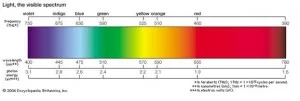Light, electromagnetic radiation that can be detected by the human eye. Electromagnetic radiation occurs over an extremely wide range of wavelengths, from gamma rays with wavelengths less than about 1 × 10−11 metre to radio waves measured in metres. Within that broad spectrum the wavelengths visible to humans occupy a very narrow band, from about 700 nanometres (nm; billionths of a metre) for red light down to about 400 nm for violet light. The spectral regions adjacent to the visible band are often referred to as light also, infrared at the one end and ultraviolet at the other. The speed of light in a vacuum is a fundamental physical constant, the currently accepted value of which is exactly 299,792,458 metres per second, or about 186,282 miles per second.

Types of Light
To understand light you have to know that what we call light is what is visible to us. Visible light is the light that humans can see. Other animals can see different types of light. Dogs can see only shades of gray and some insects can see light from the ultraviolet part of the spectrum. The key thing to remember is that our light is what scientists call visible light.
Scientists also call light electromagnetic radiation. Visible light is only one small portion of a family of waves called electromagnetic (EM) radiation. The entire spectrum of these EM waves includes radio waves, which have very long wavelengths and both gamma rays and cosmic rays, which are at the other end of the spectrum and have very small wavelengths. Visible light is near the middle of the spectrum.

